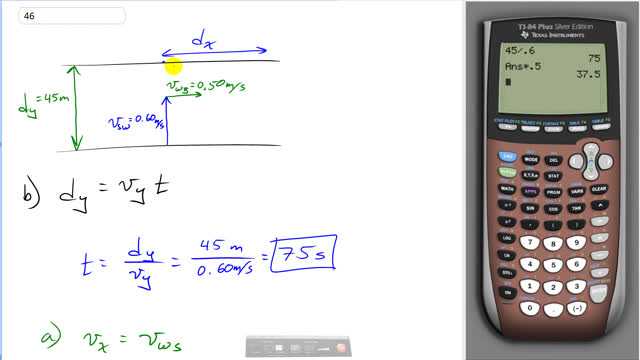
A swimmer is capable of swimming 0.60 m/s in still water.
- If she aims her body directly across a 45-m-wide river whose current is 0.50 m/s, how far downstream (from a point opposite her starting point) will she land?
- How long will it take her to reach the other side?

In order to watch this solution you need to have a subscription.
This is Giancoli Answers with Mr. Dychko. This swimmer directs herself directly across the river at 0.6 meters per second; the river goes downstream at 0.5 meters per second and the river is 0.5 meters wide and the question is how far downstream will she reach the other side of the river? So she's gonna be going somewhat in this direction that's gonna be her resultant velocity and so she's not gonna actually reach this point in the opposite side that she's aiming for initially instead she will end up somewhere down here; so what is that distance? And then the next question is, how long does it take her to get across? But the easier question to answer first is the time; we know the y-component of her velocity we'll call this d y and it equals v y times t and we know v y because the y-component of this resultant velocity is her velocity the swimmer with respect to the water because the water with respect to the river bank has no y-component. We'll find t by dividing both sides by v y and so the time is this y-displacement divided by the y-component of the velocity. So that's 45 meters divided by 0.6 meters per second which is 75 seconds and then we can use that in part (a) to figure out how far downstream she will reach the opposite shore because we know how long she spends swimming—75 seconds— and we know the x-component of her velocity as well which is entirely due to the water with respect to the river bank which is 0.5 meters downstream, meters per second. So the x-displacement then is v x times t and that's the velocity of the water with respect to the shore— I guess I called it up bank up there didn't I so put a B there— times time. So that's 0.5 meters per second times 75 seconds and that gives 38 meters downstream will be this distance here where she will reach the river bank 38 meters downstream from where she originally intended.
For part a, why do we use the current velocity and not the resultant velocity to solve how far downstream she will land?
Thanks!
Hi aheumangutman, "downstream" is the "x-direction" in the video. In order to know displacement in that direction (which is the "x-component" of the resultant displacement), we need to use the velocity along that direction. This is the "x-component" of the resultant velocity, but there's no need to do calculations for this "x-component" since the x-component is the speed of the current. In order to find the displacement along a certain direction, we need to know the velocity only along that direction.
Hope that helps,
Mr. Dychko